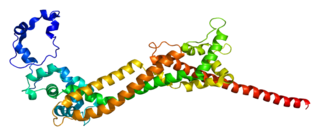
Excitatory amino-acid transporter 5 (EAAT5) is a protein that in humans is encoded by the SLC1A7 gene.

MAS-related GPR, member F, also known as MRGPRF, is a human gene.

Guanine nucleotide-binding protein G(t) subunit alpha-2 is a protein that in humans is encoded by the GNAT2 gene.

Myosin-14 is a protein that in humans is encoded by the MYH14 gene.

Single-stranded DNA-binding protein 2 is a protein that in humans is encoded by the SSBP2 gene.

Mitochondrial thiamine pyrophosphate carrier is a protein that in humans is encoded by the SLC25A19 gene.

GC-rich sequence DNA-binding factor is a protein that in humans is encoded by the GCFC2 gene.

Putative RNA-binding protein 15 is a protein that in humans is encoded by the RBM15 gene. It is an RNA-binding protein that acts as a key regulator of N6-Methyladenosine (m6A) methylation of RNAs

Dyslexia susceptibility 1 candidate gene 1 protein is a protein that in humans is encoded by the DYX1C1 gene. This protein contains 420-amino acids with 3 tetratricopeptide repeat (TPR) domains, thought to mediate protein–protein interactions.

Disheveled-associated activator of morphogenesis 1 is a protein that in humans is encoded by the DAAM1 gene. Evidence of alternative splicing has been observed for this gene but the full-length nature of these variants has not been determined.

Growth arrest-specific protein 2 is a protein that in humans is encoded by the GAS2 gene.

Uncharacterized protein C9orf78 is a protein that in humans is encoded by the C9orf78 gene.

Uncharacterized protein KIAA1377 is a protein that in humans is encoded by the KIAA1377 gene. Also known as Cep126, the protein has been shown to localize to the centrosome. Furthermore, it is found at pericentriolar satellites and the base of the primary cilium. Depleting Cep126 leads to dispersion of pericentriolar satellites, in turn disrupting microtubule organization at the mitotic spindle.

Protein DGCR6 is a protein that in humans is encoded by the DGCR6 gene.

SH3 and PX domain-containing protein 2A is a protein that in humans is encoded by the SH3PXD2A gene.

NADH dehydrogenase [ubiquinone] 1 subunit C1, mitochondrial is an enzyme that in humans is encoded by the NDUFC1 gene.

Zinc phosphodiesterase ELAC protein 1 is an enzyme that in humans is encoded by the ELAC1 gene.

The Glycine receptor subunit alpha-3 is a protein that in humans is encoded by the GLRA3 gene. The protein encoded by this gene is a subunit of the glycine receptor.

Chymotrypsin C, also known as caldecrin or elastase 4, is an enzyme that in humans is encoded by the CTRC gene.

Transmembrane protein 216 is a protein in humans that is encoded by the TMEM216 gene.




















